
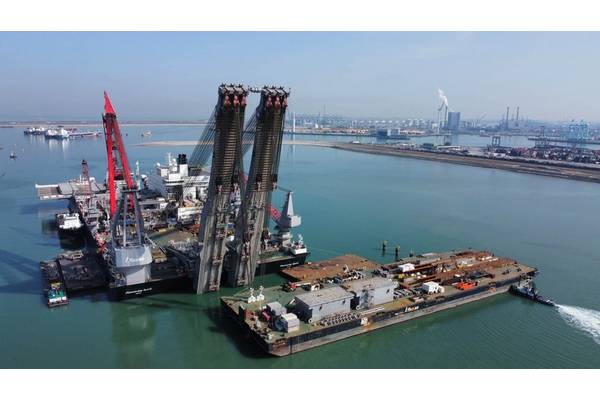
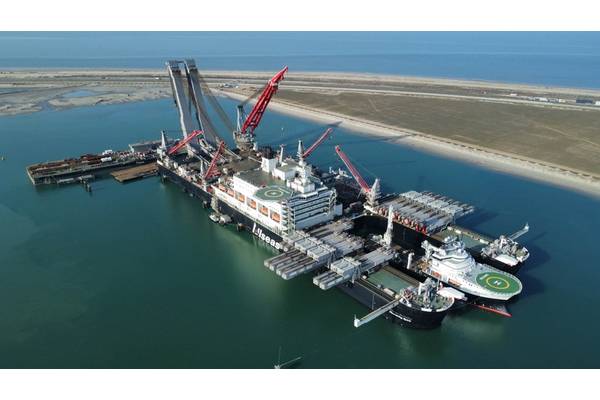
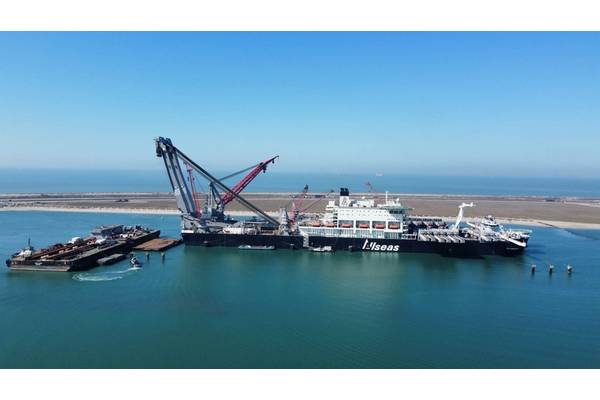
Edward Heerema is founder and president of Allseas, which brought the world’s largest construction vessel, Pioneering Spirit, to the market. The company, which also brought innovation to the pipelay sector, has added its latest trick to Pioneering Spirit – its jacket lift system. But Allseas is also targeting deepsea mining and has its sights on the offshore wind market. Elaine Maslin caught up with Edward Heerema to find out more.
The first time I met Edward Heerema was at the company’s offices in Delft, in the Netherlands. As a Brit, I was used to not getting milk with my cup of tea in Dutch offices (or KLM flights). But, as an international company, Allseas was used to my kind and milk was offered.
We were there to discuss progress of the 382m-long heavy lift and pipelay mega vessel Pioneering Spirit. Delays in the shipbuilding process and a decision to increase the 48,000-tonne topside lift vessel’s already substantial width to 124m (to accommodate even more platforms) had put the project behind schedule. It was an immense undertaking that appeared to some like a massive gamble. Would she work? With a multi-billion price-tag, it couldn’t afford not to.
What’s happened since both demonstrates Allseas’ single-minded focus, but also its willingness to alter plans and flex to demands, from adapting or renaming Pioneering Spirit to offering the Brit some milk in her tea.
Edward Heerema is also someone who has confidence in engineering, whether that’s in pipelaying on dynamic positioning, complex single-lift motion compensation systems or deepwater pipelay, and now also deepsea mining and installing future up to 20 MW offshore wind turbines. For him and Allseas, the engineering involved in Pioneering Spirit wasn’t a gamble, even if the economics are perhaps challenging in today’s market. Since its launch in 2016 to March 2022, the vessel has lifted a total of 240,000 tons of topsides in decommissioning and installation projects. This year will be a bumper year for the ship. She’s scheduled to lift and transport a record 125,000 tons of platform structures, using both its topsides and jacket lift systems. Since her launch, she’s also laid 4,200 km of 32-48 inch pipeline in 41 to 2,200 m water depth.
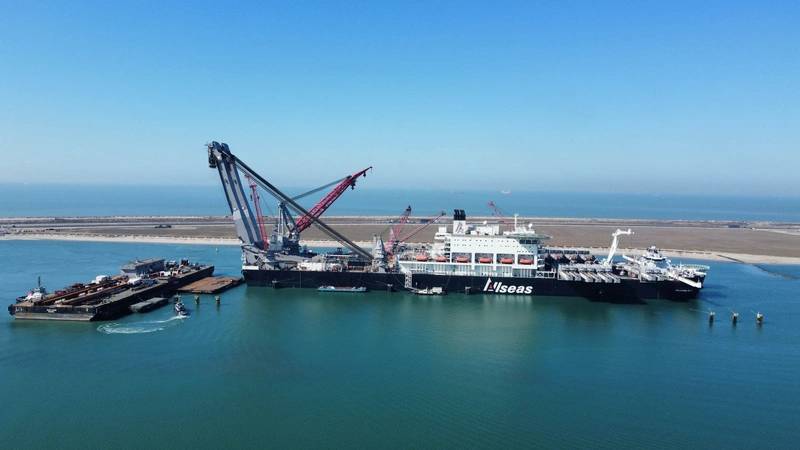 Pioneering Spirit JLS beams upended to 110 degrees. Photo courtesy Allseas
Pioneering Spirit JLS beams upended to 110 degrees. Photo courtesy Allseas
An established tool in the market
Pioneering Spirit is very much now a well-established tool. “When we clarify with clients a contract or have to be on a bid list, there are no longer any more questions about whether she will work,” Edward says. “She has done every project in a magnificent way. Maybe we have been lucky, because we have had hardly any weather down time, but because the vessel is so enormous it moves very little in the waves and then the motion compensation system takes care of the rest. Her workability has been great and she has never disappointed us.”
Of course, the first big lift, Brent Delta in 2017, was a heart-stopping moment. “That was the first really big job,” says Edward. “The first job, the Yme removal (13,500 tons) for Repsol in 2016, was very special. We were all really nervous that the system wouldn’t work. Rationally, we couldn’t question at all that it would work, because it had been tested and tested and simulated and simulated. But still, I remember very well being there on board and the button was pressed, and you hope she goes, and she went, and that was fantastic. But the real emotional success was the lifting of the Brent Delta topsides, because at a weight of 24,000 tons that was a world lifting record.”
Beating records
Since then, projects with Pioneering Spirit have become routine work, beating its own record for the world’s heaviest single-lift offshore with the 26,000 ton Johan Sverdrup process platform (P1) topsides installation in 2019. Pioneering Spirit installed P1 on a Tuesday, followed by the field’s 18,000 ton living quarters topsides just a couple of days later. These were two of four topsides installations Allseas is contracted to perform on Johan Sverdrup, the latest being the 20,000 ton P2 topsides, completed this March.
Despite these successes, it’s been a relatively challenging period. “The amount of work, 25 lifts in five years, has been reasonable, but not impressive,” says Edward. The pandemic extended the depression that hit in 2014, reducing activity. “There’s not been sufficient work for everybody,” he says. “None of the installation contractors have had enough work. Everybody is surviving, because even when you get a reasonable amount of work, it is at very low prices because of the enormous competition in the installation and removal business. That aside, we have done relatively well. We have got very reasonable amount of work and we’ve been nicely busy with installations, with removal, both big and small and some pipelay projects.”
Activity growth
It’s clear that there’s already an uptick in activity, based on Pioneering Spirit’s 2022 schedule alone. An increase in offshore spending is expected to continue. Even before the war in Ukraine pushed prices up to new highs, there were also predictions that offshore upstream spending would rise to 2014 levels again, by 2030. The war is also forcing energy policy change. Some of that is about increasing oil and gas output, but also increasing renewables capacity. While Edward doesn’t believe offshore wind will make any substantial dent in the dominance of oil and gas in the global energy system any time soon, he does see it as a nice addition, including a fill-in work for Pioneering Spirit.
Indeed, Pioneering Spirit completed its first offshore wind project last year, installing the Saint Nazaire offshore windfarm subsea station 2,100 ton topsides and 1,200 ton jacket, in the Bay of Biscay. This was using the vessel’s 5,000 ton tub-mounted Huisman crane, installed after the vessel entered service as a useful additional tool. The same crane has since installed the 3,870 ton Hollands Kust Zuid Alpha transformer station in the Dutch North Sea and will shortly install the Beta transformer station in the same wind farm (read more on page 42). Later this year, Pioneering Spirit will install the 10,500 ton Dolwin 6 transformer topsides, 5,000 ton jacket and bridge in the German North Sea.
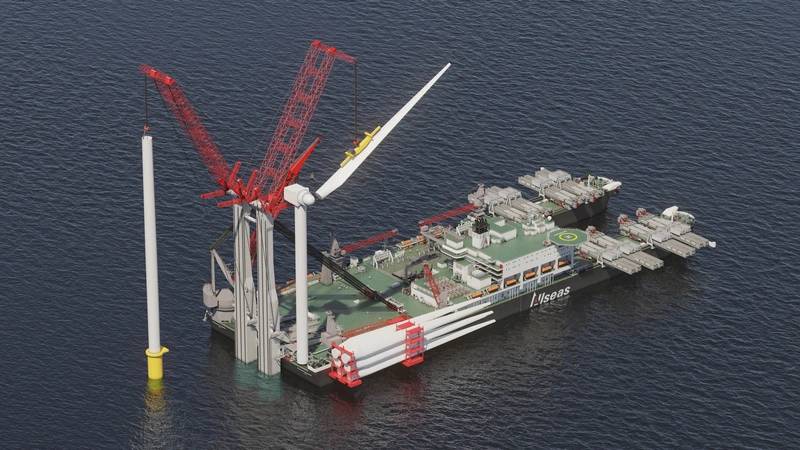 CutPioneering Spirit wind installation concept. Photo courtesy Allseas
CutPioneering Spirit wind installation concept. Photo courtesy Allseas
The new jacket lift system
Allseas will soon be targeting more and larger jackets with its new 25,000-tonne jacket lift system (JLS). The JLS was initially planned to be added to the vessel in 2016, but pipelay work with the vessel’s massive stinger took precedence and since then fabrication delays and COVID have also taken their toll. However, it’s now almost ready for its first project. The system has two, aft-mounted 170m-long lifting beams used to lift then upend jackets onto the vessel’s deck, with the jacket then resting on top of the beams, for transport, without needing sea fastening.
Test lifts of the system were carried out in late February into early March, and systems testing will continue, leading up to lifting out the eight-legged steel jacket of Ninian Northern, 240 miles east of Aberdeen in the northern North Sea, scheduled for April.
Ninian Northern, which came on stream in 1980, ceased production in 2017 and saw its topsides removed, by Pioneering Spirit, in 2020. The remaining jacket sits in 141m water depth, making it a substantial structure, weighing around 15,500 tons with an estimated 2,000 tons of marine growth. But it’s also subject of a derogation order, so that the bottom third of the jacket can be left in place, leaving the top third, weighing about 8,500 tons, to be lifted out (the jacket legs are pre-cut using a castellated pattern to prevent it from shifting).
Targeting offshore wind
Once proven, the JLS offers another revenue stream for Pioneering Spirit. But Allseas is also eying another task for the JLS. “A new challenge is the installation of big windmills,” says Edward. “Big windmills today are 13 MW, 14MW. They are going up to 15 MW and people talk about 20 MW, so we have developed a system that can handle up to 20 MW. By weight it’s nothing, but in terms of technical challenge, it’s very interesting because the windmills are very big, the blades are extreme sizes and installation is at enormous heights. We think Pioneering Spirit is a big vessel, but if you take the biggest windmill of the future, she is tiny in comparison.”
Edward says Allseas has developed a few solutions for these large windmill installations, based on an extension of the JLS. “When erected, the JLS is ideal to reach high and install big windmills,” he says. “We’re very fortunate that the JLS is very suitable for that and you can take advantage of a vessel that’s immensely stable, has a good DP system and a lot of deck space.” Final designs are being worked on, only targeting these larger turbines, likely on fixed foundations, but potentially also floating, and Allseas will be building one soon, Edward says.
A future for Amazing Grace?
Another project Allseas had been working on was Amazing Grace – a vessel that would dwarf Pioneering Spirit’s 48,000 ton topsides lift capacity at 72,000 ton topsides lift capacity. This project was “frozen” in 2020 due to the depressed market. But that’s not to say it’s permanently shelved, says Edward. “We did decide to finalize the design,” he says. “We’ve done the complete basic design so that when it is required we could move relatively quickly, do the detailed design in a year or so, and start building. We wanted to be able to say to ourselves we have a real working solution that we can build if we have to.”
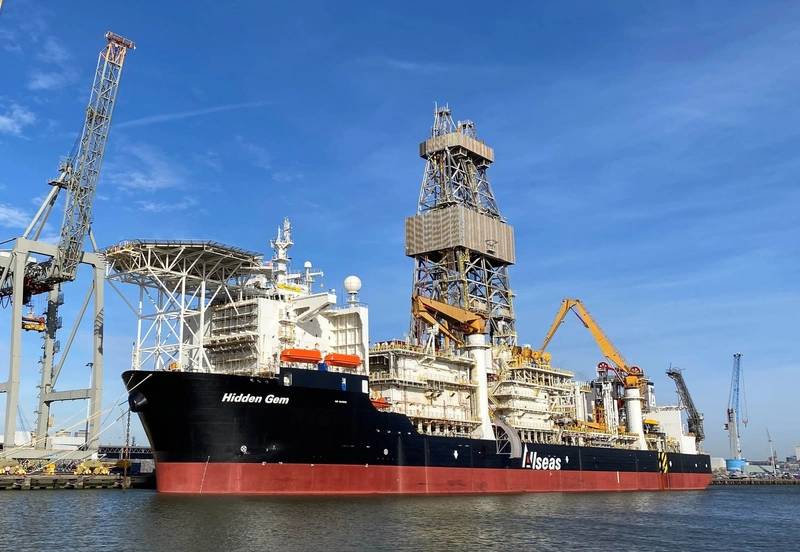 Allseas Hidden Gem. Photo courtesy Allseas
Allseas Hidden Gem. Photo courtesy Allseas
The not so Hidden Gem
Instead, Allseas has another project to focus on: deepsea mining. The company acquired the 228m-long Vitoria 10000 drillship in 2020 to convert it into a polymetallic nodule collection vessel, in partnership with The Metals Company (TMC, formerly DeepGreen Metals Inc.). TMC’s goal is harvesting polymetallic nodules, containing high grades of nickel, manganese, copper and cobalt, from the Clarion Clipperton Zone in the Pacific Ocean. These will be used for battery metal precursor materials and manganese silicate product expected to be used in manganese alloy production for the steel industry.
As well as converting the vessel, Allseas has developed and built a robotic seabed collector, a riser-based system to transport nodules to the surface and a launch and recovery system for the collector. A deployment system for the collector and the riser system has also been built, as well as an umbilical handling reel system.
According to The Metals Company, the piloted system is expected to be upgraded to a commercial system with a production capacity of 1.3 million tons of wet nodules a year by Q4 2024. The two companies are also already discussing acquiring a second vessel, a Samsung 10000, which would be converted to have 3 million ton capacity of wet nodules.
Collector testing
“We have built the collector, and it is being tested at the moment,” says Edward. The collector, measuring 12m-long, 6m-wide and 5m-tall, was designed in house then built at Allseas’s Heijningen yard in the Netherlands. “We know a lot about subsea robotics, so we were able to do a lot of that ourselves. We’ve used underwater trenchers for 25 years. We know the deep sea well, we’ve laid pipe to almost 3,000 m water, so we are in our own field there. We feel comfortable we can solve the outstanding problems.”
Testing has been taking place in the North Sea. Next it will be taken down to 2,500m depths for drive tests off the Canary Islands, followed by tests in 1,500 m depths deploying the riser and the collector, connecting them, then bringing them back onboard. Then, this summer, the system will be taken to 4,500m depth in the Clarion Clipperton Zone. There, it will perform its first pilot testing of nodule collection.
Part of this will be research into how these operations impact the environment. “We are giving that a lot of attention,” says Edward. “The Metals Company is conducting a very intensive research program with the science community and during pilot tests part of it is scientific research while collecting nodules. It’s also part of the preparation process to get green light from ISA (International Seabed Authority).” There’s also been work looking at the potential plumes created during collection, which has been a concern. “What we’ve observed is that when plumes do form they settle within a few hundred meters. So it looks very favorable. But of course, we are taking all criticism and worries seriously and do a very thorough evaluation of how we affect the seabed with our system.”
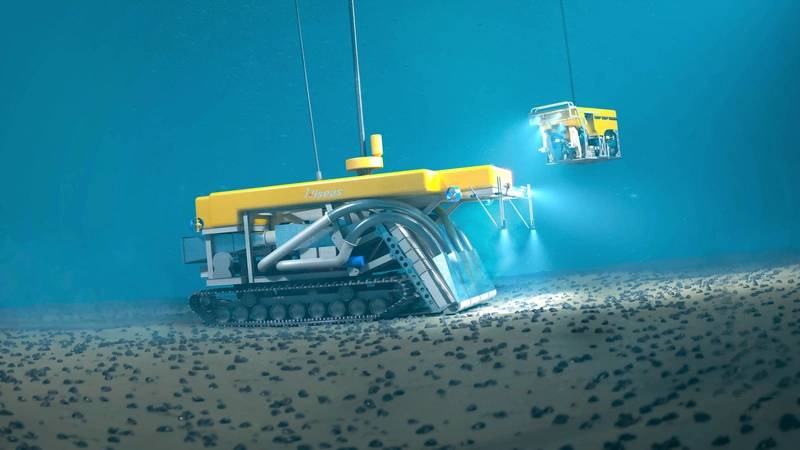 Allseas polymetallic nodule collector. Photo courtesy Allseas
Allseas polymetallic nodule collector. Photo courtesy Allseas



